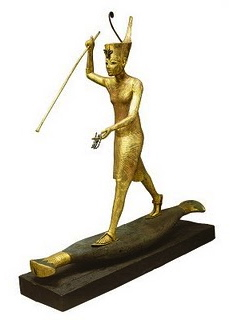UCLA Professor Willeke Wendrich just got back from an Egyptian archeological dig in December. She says she could detect a "longstanding unhappiness" in lower- and middle-class citizens, alongside whom she worked -- rooted in, among other frustrations, a "lack of freedom" and "lack of things to look forward to for youth."
One of Wendrich's anecdotes, a portrait of the times: highly educated engineers reduced to working as taxi drivers.
The professor says she's been checking in with many friends and associates in Egypt during this uprising, making sure they're all right. But one other side-effect of the chaos has her worried: Ancient Egyptian artifacts are being targeted by looters.
In particular, she mourns the demolition of a "gorgeous" collection of gilded wooden statues at Cairo's world-famous Egyptian Museum.
"These were not antiquity thieves, this particular batch," she explains, guessing the looters must have thought the gilded part was real gold, smashing the statues and trying to run off with the shiny part -- even though they're far more valuable whole. Wendrich sounds personally pained as she remembers seeing the remains of the Tut statue on the news: only a "dark brown base with golden feet."
Catch a glimpse in this MSNBC report, at 01:15:
Click Here for the Link - LAWEEKLY
In the video, another Egyptian expert says of the museum: "It hurts; it really hurts. ... It's like our Smithsonian."
"It is world heritage," Wendrich agrees. "It's really important. It's a huge loss."
Since then, the heads of two mummies were also reported as ripped from their bodies in the museum.
Though Wendrich says that, in general, Egyptians "aren't against excavation of cemeteries," they're still "very proud of their cultural heritage." And indeed, it appears the few looters who have chosen to take advantage of the situation are being countered by a band of artifact angels, as reported by the New York Post:
Before the army arrived, young Egyptians -- some armed with truncheons grabbed off the police -- created a human chain at the museum's front gate to prevent looters from making off with any of its priceless artifacts.
"They managed to stop them," Hawass said. He added that the would-be looters only vandalized two mummies, ripping their heads off. They also cleared out the museum gift shop.
In a Fox News report from earlier today, Minister for Archeology Zawi Hawass says the damage was much more extensive than 10 statues and two mummies, but seems to think it can all be restored:
"Thanks God," Hawass said in his thick Egyptian accent, "some [looters] entered [the Cairo Museum] when it was dark. They opened thirteen [glass] cases on the top floor. It was haphazard. They did not know what they were looking at. They were looking for gold. When they saw they were antiquities in their hands, they threw them to the ground. They broke seventy artifacts - statues. All of them, we can restore them. I can tell you: The Cairo Museum, thanks God, is safe."Wendrich describes to us the false state of democracy that has existed in Egypt under President Hosni Mubarak, whom protestors are currently demanding bow out of power:
"In the past election, I know nobody who went to vote," she says. "They think it's all pre-decided anyway. ... They're absolutely fed up with the figurehead. He stands for a complex in which the military and a couple of business families basically hold all the assets in Egypt."
However, in terms of the protest and surrounding media storm, she does make it clear that life goes on for most Egyptians.
"Basically, there's a couple centers," she says. "Outside of that, Egypt continues as it normally does. ... What the media is portraying is really going on. But of course the media has no interest in showing a farmer that just goes on farming -- but that's whats really going also."
The professor adds that she will definitely focus on the current unrest, and the museum looting in particular, in her Ancient Egyptian Civilization and Egyptian Archeology lectures at UCLA this week.
| UCLA |
| Willeke Wendrich, professor of Egyptian Archeology at UCLA |


No comments:
Post a Comment